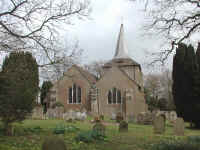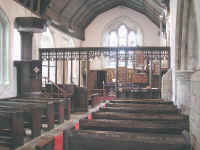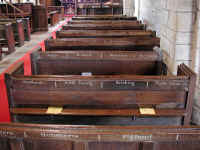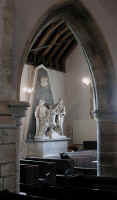| Pew Renting - the practice of paying a church rate
in order to maintain suitable seating in the church for one's
family and servants - was common in the seventeenth and eighteenth
centuries. Gilbert White, the naturalist and
antiquarian, wrote of his church at Selborne in Hampshire: '
. . . nothing can be more irregular than the pews of this church
which are of all dimensions and heights, being patched up
according to the fancy of the owners.' This was a not unusual
description of many a parish church in the 17th and 18th
centuries, because the order of seating reflected a rigid social
structure and was regarded as
a matter of the utmost importance by those concerned.
Rented accommodation from the very elaborate and often
ostentatious family pews (see Croft,
Yorkshire, NR) to rectangular high-sided box-pews,
which provided comparative privacy and comfort (see Whitby,
Yorkshire, NR) and benches which were reserved for
particular farmsteads and tenements. Of course, additional rented
accommodation resulted in additional income for the Church
wardens, often to the exclusion of those who could not afford to
pay for their seats and were crowded together on makeshift forms
in the aisles and the galleries. Such was the lot of the
unfortunate ordinary parishioner, and it was not surprising that
this led in many instances to defection to the Independent and
non-conformist chapels, where there was relatively little social
snobbery.
[CEngPC]
|







